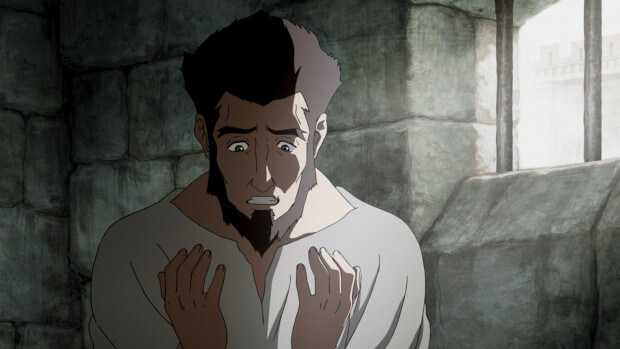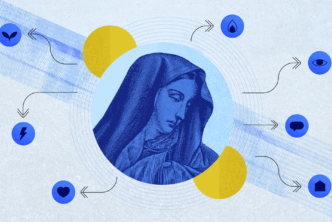This Easter season saw the release of two major films about Jesus: The Young Messiah, based on Anne Rice’s 2005 novelization of Jesus’ earliest years, and Risen, a biblical epic recast as a historical mystery starring Joseph Feinnes. Depicting biblical stories on the screen is always a risky business, as the creators of ABC’s controversial Of Kings and Prophets learned when that show was abruptly cancelled early this week. Whatever its theological pitfalls, and whatever the critical consensus, any new film adaptation of the life of Christ probably won’t become the most-watched film of all time.
That honor goes to another movie about Jesus.
On first blush, 1979’s JESUS, affectionately known as “the JESUS film,” is an unlikely candidate for the title “Most Watched Movie Ever.” But for decades, Cru (formerly Campus Crusade for Christ) has used the movie in their evangelism efforts, playing it for so many people that in 2003 The New York Times reported JESUS may indeed be the most viewed film of all time.
Now the Jesus Film Project, the ministry behind the original movie, is releasing My Last Day, a new short film that incorporates audio from the original JESUS film set to brand new animation. The Jesus Film Project made My Last Day in the Japanese style of animation called anime, and that was a strategic move. After all, anime is no longer a niche obsession. As far back as 2003, Hayao Miyazaki’s anime masterpiece Spirited Away won the Academy Award for best animated feature, and since then the genre has only grown in popularity, particularly among millennials. By recruiting top animators and portraying the gospel story in this popular genre, the producers of My Last Day hope to recreate the Jesus film phenomenon for a new generation.
Faithlife’s Daniel Di Bartolo spoke with Mike Peckham, director of film production at The Jesus Film Project, about the new movie, the challenges of adapting Scripture for the screen, and the legacy of the JESUS film.
The Jesus Film has been been used for many years as a tool for evangelism and missions. Why did you choose to adapt it for anime? Why did you choose that style of animation?
Around 2003 we became increasingly impressed that not only were we stewards of hundreds of JESUS film translations, but also all of the recordings that were used to make these translations. Because we had been recording each voice separately since the earliest translations, we were essentially stewards of an audio ‘database’ of translations of much of the Gospel of Luke. In addition to spin-off products such as an audio drama version of JESUS and a children’s version, we wondered if there might be something we could do in the realm of animation.
Shortly afterwards, in the Lord’s providence, we met Barry Cook. Barry had been co-director of Disney’s Mulan at the Florida studio here in Orlando. Barry had been a big fan of the work of the Jesus Film Project for many years. Together we became convinced that there might be something from the life of Jesus, that used existing translations from the JESUS film, that we should pursue together. With further consultation with our staff in Eastern Europe, we decided to pursue something around the crucifixion as a ‘pilot project’ of this idea.
The idea of using Japanese style anime came from Barry’s conversation with our staff in Eastern Europe. Our staff were seeing that anime was incredibly popular where they were as well as in other parts of the world. Anime has developed a global appeal that is rather unique, but there was very little biblical content being done in this style of animation.
Barry felt that anime would be a great fit for retelling the story of Jesus, because viewers of anime already expect this type of animation to deal with violence, spiritual themes and the human condition. In fact, he dubbed our efforts together ‘visual translation’.
We had translated the soundtrack for JESUS hundreds of times back then, but this was to be a ‘visual translation’ of the same story into one of the key visual forms of a new generation.
How do you balance the need to be faithful to the gospel texts with artistic license?
We, along with Barry, had a pretty clear lodestar for this: if the Scripture is clear on something or gives you dialogue, use it and be faithful to it. For everything else Barry was a tremendous help to us in seeking to be faithful to the text but bringing in the skills of great storytellers to support this basic idea of a ‘visual translation.’
Our dialogue source was already coming from the JESUS film which uses about half of the Gospel of Luke. During the scripting and planning phases for My Last Day we had story and theological consultants. During production we worked with Brethren Entertainment who connected us with Studio 4C. Even when the story went to Studio 4C in Tokyo, the artists and staff there were fascinated by the story and threw themselves in to researching and making the animation as visually accurate as possible in their own unique style of anime.
Who did you make My Last Day for?
We were primarily thinking of a global audience of 15- to 30-year-old people. At the time we thought it might be primarily urban people who have more exposure to anime. Interestingly though, we have found that the visual storytelling of Jesus’ crucifixion in My Last Day is so gripping that not only is it well received by urban audiences but rural audiences as well. In fact, the age range seems to be broader—anyone that likes compelling animated films.
Image courtesy the Jesus Film Project
What are some difficulties that you encountered as you adapted the story of Jesus’ death and resurrection to an anime film?
We were concerned that the film be faithful to Gospel of Luke, and yet be a real expression of Japanese sensibilities for their art form. We also did not know what it would be like working with a Japanese studio. Again, in the Lord’s providence, he provided Scott Wong and his team at Brethren Entertainment. Scott worked out the translation issues for us to communicate with Studio 4C. He also helped the team in Tokyo understand the story and in fact it became a moving ‘gospel moment’ for many of them to understand how My Last Day was based on a real life; many of them thought of Jesus as more of a mythical super hero.
How can churches, ministries, and individuals use My Last Day in their efforts to tell their friends about Jesus?
The nine-minute version of My Last Day is of course freely available to stream or download on our Jesus Film App and our JesusFilmMedia.org website in over 125 languages. Something new we are doing is a gospel presentation based on My Last Day that uses two clips from the film as well as still images combined with the text from Cru’s “Knowing God Personally” tract. You can see this at sowhatsitallabout.com/mld and encourage anyone in your sphere to share it with everyone in their social network. We worked hard to make it viewable even on the average smart phone so it truly can be shared globally.
As a director, tell us about how you view the role of film as a tool for evangelism. What are some strengths and weaknesses that you see in film as a tool for evangelism?
Evangelism, at it’s core, is the persuasive communication of message—in our case, the most important message someone can hear and respond to. In our generation, film, and specifically short film, is a medium many people are engaging with daily, even hourly. Creating evangelistic tools in a film context, delivered by smartphones and web has accelerated the adoption by Christians looking to share with their friends. This in turn is well received by those they are sharing with because we all love watching videos.
How can people get involved in Christian filmmaking?
The God we serve is the Creator of the universe, all we see and can not see. The passion we each have to create things, for beauty, has come from him! We need to engage with that part of who God has created us to be. So, read, write, shoot, go to college and study film. Today we each have a better camera in our pockets than I had in college. My nine-year-old son has been making amazing films with my phone. He understands visual story and I get to encourage him in trying it out. Telling his stories. We can each tell stories, get out there and tell them.
Film is a collaborative art form, that is what is so fun about it. I started working with a bunch of friends and a video camera and we made films. Start there, just start making films, you’ll make mistakes at the beginning, we all do, but we get better by doing it. What is your church doing with film? Can you get involved there? Are there some sermon illustrations that the pastor or youth pastor would love to have to show? Ask them and see what you can do.
We can get more films made by supporting them. It may be buying a ticket on the opening weekend (that is where it really counts in any film nowadays), or helping fund a Kickstarter campaign for a Christian film (there are a ton out there), or you can partner with us here at the Jesus Film.
***
Reflect on Christ’s passion with The Jesus Film Project’s My Last Day. Then sign up to receive daily videos from top scholars reflecting on Jesus’ Journey to the Resurrection. Sign up below, or learn more about the journey.







